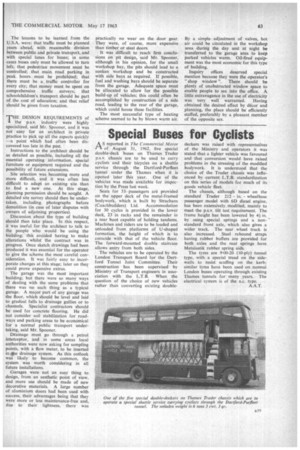Special Buses for Cyclists
Page 65

If you've noticed an error in this article please click here to report it so we can fix it.
AS reported in The Commercial Motor of August 31, 1962, five special double-deck buses on Thames Trader p.s.v. chassis are to be used to carry cyclists and their bicycles on a shuttle service through the Dartford-Purfleet tunnel under the Thames when it is opened later this year. One of the vehicles was made available for inspection by the Press last week.
Seats for 33passengers are provided on the upper deck of the metal-framed bodywork, which is built by Strachans (Coachbuilders) Ltd. Accommodation for 30 cycles is provided in the lower deck, 23 in racks and the remainder in a rear boot capable of holding tandems. Machines and riders are to be loaded and unloaded from platforms of U-shaped formation, the height of which is to coincide with that of the vehicle floor. The forward-mounted double staircase allows entry from both sides.
The vehicles are to be operated by the London Transport Board for the Dartford Tunnel Joint Committee. Their construction has been supervised by Ministry of Transport engineers in association with the L.T.B. When the question of the choice of new vehicles rather than converting existing double deckers was raised with representatives of the Ministry and operators it was stated that a lighter vehicle was favoured and that conversion would have raised problems in the stressing of the modified bodywork. It is understood that the choice of the Trader chassis was influenced by current L.T.B. standardization on this series of models for much of its goods vehicle fleet.
The chassis, although based on the standard Trader 212 in. wheelbase passenger model with 6D diesel engine. has been extensively modified, mainly to meet the p.s.v. tilt test requirement. The frame height has been lowered by 4-1 in. by using special springs and a nonstandard front axle, which also gives a wider track. The rear wheel track is also increased. Steel rebound straps having rubber buffers are provided for both axles and the rear springs have Metalastik rubber spring aids.
The tyres are 9-00-20 (10-ply) tunnel type, with a special tread on the sidewalls to resist scuffing on the kerb: similar tyres have been used on normal London buses operating through existing Thames tunnels for many years. The electrical system is of the a.c. type.
A.A.T.












































































































